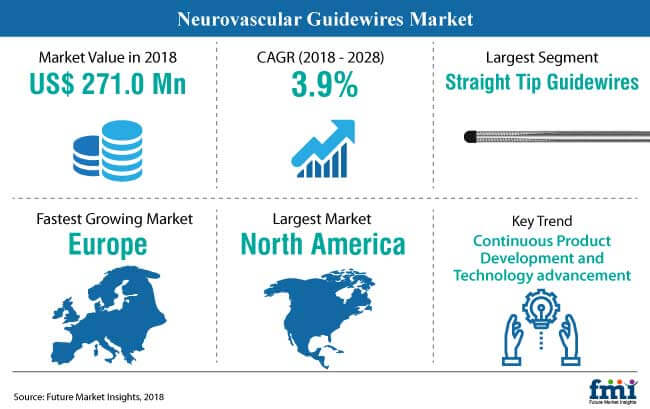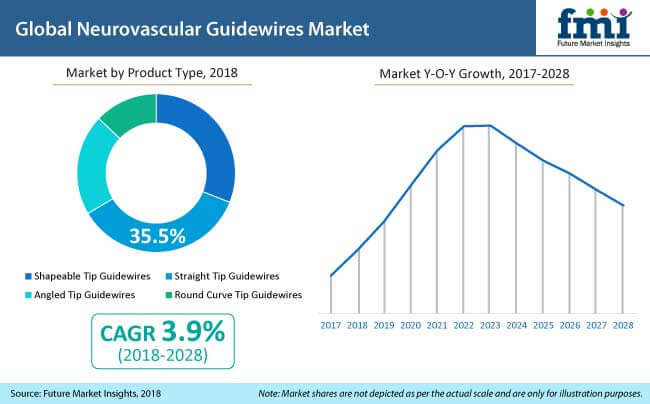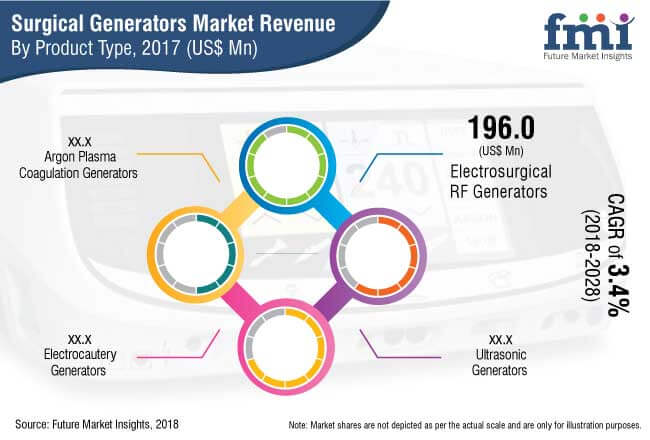
Neurovascular Guidewires Market - Key Research Findings
- Global neurovascular guidewires market size in 2018 – Nearly US$ 262 Mn
- Neurovascular guidewires market is projected to record a CAGR of 3.9% during the forecast period (2018–2028).
- According to the Centers for Disease Control and Prevention (CDC),
- The prevalence of ischemic strokes (2016) was approximately 87% in the US alone.
- North America and Europe will remain the largest regional markets for neurovascular guidewires.
- The rising number of minimally invasive surgeries & neurovascular neuroradiology procedures, advancements in technology, the adoption of new equipment, and the rising prevalence of neurovascular diseases are among the key factors that are likely to assist growth of the neurovascular guidewires market.
- East Asia holds a high growth potential for the neurovascular guidewires market, as the demand for new treatment options is rapidly increasing, driven by the rising burden of aneurysm and neurovascular diseases in the region.
- Straight tip guidewires are likely to witness maximum growth rate in the neurovascular guidewires market through 2028.
- The nature of micro-sensors and fiber optics, ease of operability, and high accuracy in neurovascular intervention procedures have resulted ain extensive usage of laser straight tip guidewires.
Request Sample Report @ https://www.futuremarketinsights.com/reports/sample/rep-gb-3121

Top 4 Factors Shaping the Neurovascular Guidewires Market
- Rising number of minimally invasive surgeries and neurovascular neuroradiology procedures
According to the Centers for Disease Control and Prevention, about 87% of all strokes are ischemic strokes and around 10% of these strokes result in death within a period of one month. According to the American Stroke Association, the annual stroke prevalence in the US reach around 800,000 – resulting in approximately 130,000 deaths, every year.
The World Health Organization claims that one death by stroke occurs every 10 seconds around the world. The rising prevalence of neurovascular diseases, especially strokes & cerebral infarctions, and the requirement of surgical procedures, are expected to drive the neurovascular guidewire market.
More than 50 million surgical procedures were performed in the US in 2016 and every year, the number of surgical procedures is growing. Moreover, the preference for minimally invasive surgeries is increasing. Neurovascular guidewires are used in various minimally invasive surgeries because of their specifications such as their thinness and flexibility, which enables them to be easily inserted into the body to guide larger equipment or instruments such as feeding tubes, catheters, and others. Improvements in surgical procedures and the increasing demand for minimally invasive surgeries is boosting the usage of neurovascular guidewires during minimally invasive interventional procedures.
- Rising prevalence of neurovascular diseases is likely to boost the neurovascular guidewires market
At present, around 87% of the people worldwide are suffering from stroke, according to the Centers for Disease Control and Prevention. The incidence of ischemic stroke is predicted to increase, especially in the lower to middle-income or underdeveloped countries, according to the World Bank Group. Micro-sensors and fiber optic guidewires improve the results of several surgical procedures, thus broadening the utilization of guidewires from neurovascular diseases to coronary & urological diseases.
- Positive outcomes of clinical trials are expected to contribute to the expansion of neurovascular guidewires market
Clinical trials have demonstrated the benefits of guidewires such as lubricious coating, sterility, and biocompatibility, efficacy in the treatment procedure of aneurysm, cerebral infarction, and ischemic stroke, which is another factor estimated to the boost the neurovascular guidewires market.
The ongoing studies of new technologies to improve the quality of treatment with the help of neuro-intervention procedures, such as a gold coil at the tip for radio capacity and a distal tip that is specially engineered for neuro-intervention procedures, are expected to support the growth of neurovascular guidewires market.
Request to View TOC @ https://www.futuremarketinsights.com/askus/rep-gb-3121
- Increasing number of neurovascular neuroradiology procedures and technological advancements
The increasing number of neurovascular neuroradiology procedures is boosting the demand for access products, which is driving the usage of guidewires. Aneurysm and AVM procedures require 1.7 to 1.8 cm guidewire per procedure, and new technology innovations for the treatment of ischaemic stroke, such as stents, are driving the adoption of neurovascular guidewires. Neurovascular guidewires improve the distal navigation and trackability features of the guidewires that are used in various complex neurovascular intervention procedures.
Significant advancements have been witnessed in guidewire technology, which have resulted in the initial success rates, as well as decreased the difficulties pertaining to the usage of guidewires. Developments in guidewire technology as well as in their framework have resulted in enhanced the efficacy and safety of movable wire systems.
Neurovascular Guidewires Market Structure Analysis
- Tier 1 companies are focusing on strategic mergers, acquisitions, and collaborative agreements in an effort to strengthen sales and distribution networks.
- Asahi Intecc Co., Ltd recently signed an agreement with another industry giant, Medtronic plc, over distribution of neurovascular guidewires. The company also announced direct sales of percutaneous transluminal coronary angioplasty (PTCA) guidewires in the US.
- Stryker Corporation recently announced the acquisition of K2M Group Holdings Incorporation, over a minimally invasive solutions range.


